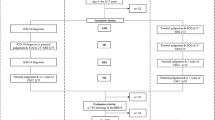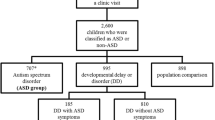Abstract
A key feature of autism is restricted repetitive behavior (RRB). Despite the significance of RRBs, little is known about their phenomenology, assessment, and treatment. The Repetitive Behavior Scale-Revised (RBS-R) is a recently-developed questionnaire that captures the breadth of RRB in autism. To validate the RBS-R in an independent sample, we conducted a survey within the South Carolina Autism Society. A total of 320 caregivers (32%) responded. Factor analysis produced a five-factor solution that was clinically meaningful and statistically sound. The factors were labeled “Ritualistic/Sameness Behavior,” “Stereotypic Behavior,” “Self-injurious Behavior,” “Compulsive Behavior,” and “Restricted Interests.” Measures of internal consistency were high for this solution, and interrater reliability data suggested that the RBS-R performs well in outpatient settings.
Similar content being viewed by others
References
Achenbach, T. M., McConaughy, S. H., & Howell, C. T. (1987). Child/adolescent behavioral and emotional problems: Implications of cross-informant correlations for situational specificity. Psychological Bulletin, 101, 213–232.
Aman, M. G., Lam, K. S. L., & Collier-Crespin, A. (2003). Prevalence and patterns of use of psychoactive medicines among individuals with autism in the Autism Society of Ohio. Journal of Autism and Developmental Disorders, 33, 527–534.
American Psychiatric Association. (1994). Diagnostic and statistical manual of mental disorders. 4th edn. Washington, DC: American Psychiatric Association.
Bodfish, J. W., & Lewis, M. H. (2002). Repetitive Behavior in Autism. Paper presented at the International Meeting for Autism Research. (IMFAR), Orlando, FL.
Bodfish, J. W., Symons, F. W., & Lewis, M. H. (1999). The Repetitive Behavior Scale. Western Carolina Center Research Reports.
Bodfish, J. W., Symons, F. J., Parker, D. E., & Lewis, M. H. (2000). Varieties of repetitive behavior in autism: Comparisons to mental retardation. Journal of Autism and Developmental Disorders, 30, 237–243.
Browne, M. W., & Cudeck, R. (1992). Alternative ways of assessing model fit. Sociological Methods and Research, 21, 230–258.
Campbell, M., Anderson, L. T., Small, A. M., Locascio, J. J., Lynch, N. S., Choroco, M. C. (1990). Naltrexone in autistic children: A double-blind and placebo-controlled study. Psychopharmacology Bulletin, 26, 130–135.
Cattell, R. B. (1966). Handbook of multivariate experimental psychology. Chicago: Rand McNally.
Charlop, M. H. (1992). Echolalia. In E. Konarski & J. Favell (Eds.), Manual for the assessment and treatment of behavior disorders with mental retardation. Morganton, NC: WCC Foundation.
Cicchetti, D. V., & Rourke, B. P. (Eds). (2004). Methodological and biostatistical foundations of clinical neuropsychology and medical and health disciplines. New York, NY: Psychology Press: Taylor and Francis. (2nd edn).
Costello, A. B., & Osborne, J. W. (2005). Best practices in exploratory factor analysis: Four recommendations for getting the most from your analysis. Practical Assessment, Research and Evaluation, 10, 1–9.
Cuccaro, M. L., Shao, Y., Grubber, J., Slifer, M., Wolpert, C. M., Donnelly, S. L., Abramson, R. K., Ravan, S. A., Wright, H. H., DeLong, G. R., & Pericak-Vance, M. A. (2003). Factor analysis of restricted and repetitive behaviors in autism using the autism diagnostic interview – R. Child Psychiatry and Human Development, 34, 3–17.
DeVellis, R. F. (1991). Scale development: Theory and applications. California: Sage Publications.
Evans, D. W., Leckman, J., Reznick, J., Carter, A., Henshaw, D., King, R., & Pauls, D. (1997). Ritual, habit and perfectionism: The prevalence and development of compulsive-like behavior in normal young children. Child Development, 68, 58–68.
Fabrigar, L. R., Wegener, D. T., MacCallum, R. C., & Strahan, E. J. (1999). Evaluating the use of exploratory factor analysis in psychological research. Psychological Methods, 4, 272–299.
Fliess, J. L., Levin, B., & Patick, M. C. (2003). Statistical methods for rates and proportions. (3rd edn) New York, NY: John Wiley.
Floyd, F. J., & Widaman, K. F. (1995). Factor analysis in the development and refinement of clinical assessment instruments. Psychological Assessment, 7, 286–299.
Frith, U. (1989). Autism: Explaining the enigma. Oxford: Blackwell.
Goodman, W. K., Price, L. H., Rasmussen, S. A., Mazure, C., Fleischmann, R. L., Hill, C. L., Heninger, G. R., & Charney, D. S. (1989). The Yale-Brown Obsessive Compulsive Scale: Part I. Development, use, and reliability. Archives of General Psychiatry, 46, 1006–1011.
Gordon, C. T. (2000). Commentary: Considerations on the pharmacological treatment of compulsions and stereotypies with serotonin reuptake inhibitors in pervasive developmental disorders. Journal of Autism and Developmental Disorders, 30, 437–438.
Kanner, L. (1943). Autistic disturbances of affective contact. Nervous Child, 2, 217–250.
Kerlinger, F. N., & Lee, H. B. (2000). Survey research. In F. N. Kerlinger, & H. B. Lee, (Eds.), Foundations of behavioral research, Fourth edition. (pp. 599–619). Orlando: Harcourt, Inc.
Koegel, R. L., & Covert, A. (1972). The relationship of self-stimulation to learning in autistic children. Journal of Applied Behavior Analysis, 5, 381–387.
Koegel, R. L., Firestone, P. B., Kramme, K. W., Dunlap, G. (1974). Increasing spontaneous play by suppressing self-stimulation in autistic children. Journal of Applied Behavior Analysis, 7, 521–528.
Langworthy-Lam, K. S., Aman, M. G., Van Bourgondien, M. E. (2002). Prevalence and patterns of use of psychoactive medicines in individuals with autism in the Autism Society of North Carolina. Journal of Child and Adolescent Psychopharmacology, 12(4), 311–322.
Lewis, M. H., & Bodfish, J. W. (1998). Repetitive behavior disorders in autism. Mental Retardation and Developmental Disabilities Research Reviews, 4, 80–89.
Lord, C., Rutter, M., & Le Couteur, A. (1994). The autism diagnostic interview-Revised: A revised version of a diagnostic interview for caregivers of individuals with possible pervasive developmental disorders. Journal of Autism and Developmental Disorders, 24, 659–685.
Lovaas, O. I., Littownik, A., & Mann, R. (1971). Response latencies to auditory stimuli in autistic children engaged in self-stimulatory behavior. Behavior Research and Therapy, 9, 39–49.
McDougle, C. J., Kresch, L. E., Goodman, W. K., Naylor, S. T., Volkmar, F. R., Cohen, D. J., & Price, L. H. (1995). A case–controlled study of repetitive thoughts and behavior in adults with autistic disorder and obsessive-compulsive disorder. American Journal of Psychiatry, 152, 772–777.
Militerni, R., Bravaccio, C., Falco, C., Fico, C., & Palermo, M. T. (2002). Repetitive behaviors in autistic disorder. European Child and Adolescent Psychiatry, 11, 210–218.
Nunnally, J. C., (1967). Psychometric theory. New York: McGraw Hill.
Pierce, K., & Courchesne, E. (2001). Evidence for a cerebellar role in reduced exploration and stereotyped behavior in autism. Biological Psychiatry, 49, 655–664.
Prior, M., & MacMillan, M. B. (1973). Maintenance of sameness in children with Kanner’s syndrome. Journal of Autism and Childhood Schizophrenia, 3, 154–167.
Rutter, M. (1996). Autism research: Prospects and progress. Journal of Autism and Developmental Disorders, 26, 257–275.
Scahill, L., McDougle, C. J., Williams, S., Dimitripoulos, A., Aman, M. G., McCracken, J., Tierney, E., Arnold, L. E., Cronin, P., Koenig, K., Kohn, A., Lam, K. S. L., & Vitiello, B. (in press, pending final revision). The Children’s Yale-Brown Obsessive-Compulsive Scale modified for Pervasive Developmental Disorders. Journal of the American Academy of Child and Adolescent Psychiatry.
Scahill, L., Riddle, M. A., McSwiggin-Hardin, M., Ort, S. et al (1997). Children’s Yale-Brown Obsessive Compulsive Scale: Reliability and validity. Journal of the American Academy of Child and Adolescent Psychiatry, 36, 844–852.
Schuck, P. (2004). Assessing reproducibility for interval data in health-related quality of life questionnaires: Which coefficient should be used? Quality of Life Research, 13, 571–586.
Schultz, T. M., & Berkson, G. (1995). Definition of abnormal focused affections and exploration of their relation to abnormal stereotyped behaviors. American Journal on Mental Retardation, 99, 376–390.
Thurstone, L. L. (1947). Multiple factor analysis. Chicago: University of Chicago Press.
Varni, J. W., Lovaas, O. I., Koegel, R. L., & Everett, N. L. (1979). An analysis of observational learning in autistic and normal children. Journal of Abnormal Child Psychology, 7, 31–43.
Wing, L., & Gould, J. (1979). Severe impairments of social interaction and associated abnormalities in children: Epidemiology and classification. Journal of Autism and Developmental Disorders, 9, 11–29.
Acknowledgment
The authors are very thankful to the families who participated in this study. They also appreciate the South Carolina Autism Society’s willingness to distribute the survey to their parent mailing list. The authors also would like to thank James W. Bodfish for allowing us to use the RBS-R in this research.
Author information
Authors and Affiliations
Corresponding author
Rights and permissions
About this article
Cite this article
Lam, K.S.L., Aman, M.G. The Repetitive Behavior Scale-Revised: Independent Validation in Individuals with Autism Spectrum Disorders. J Autism Dev Disord 37, 855–866 (2007). https://doi.org/10.1007/s10803-006-0213-z
Published:
Issue Date:
DOI: https://doi.org/10.1007/s10803-006-0213-z




